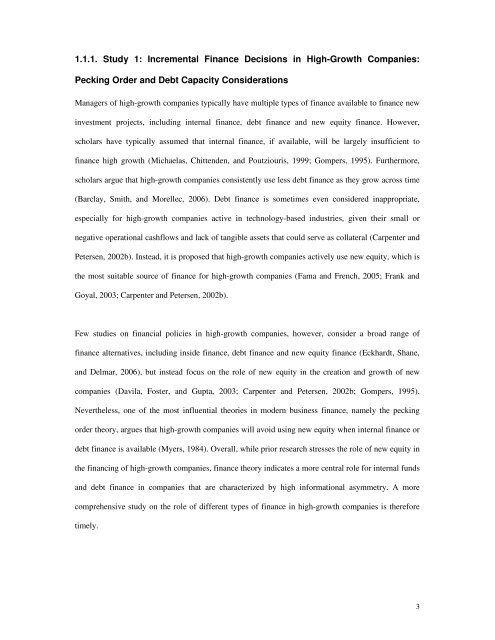Financing Unquoted High-Growth Companies: From Extending
Financing Unquoted High-Growth Companies: From Extending
Financing Unquoted High-Growth Companies: From Extending
You also want an ePaper? Increase the reach of your titles
YUMPU automatically turns print PDFs into web optimized ePapers that Google loves.
1.1.1. Study 1: Incremental Finance Decisions in <strong>High</strong>-<strong>Growth</strong> <strong>Companies</strong>:<br />
Pecking Order and Debt Capacity Considerations<br />
Managers of high-growth companies typically have multiple types of finance available to finance new<br />
investment projects, including internal finance, debt finance and new equity finance. However,<br />
scholars have typically assumed that internal finance, if available, will be largely insufficient to<br />
finance high growth (Michaelas, Chittenden, and Poutziouris, 1999; Gompers, 1995). Furthermore,<br />
scholars argue that high-growth companies consistently use less debt finance as they grow across time<br />
(Barclay, Smith, and Morellec, 2006). Debt finance is sometimes even considered inappropriate,<br />
especially for high-growth companies active in technology-based industries, given their small or<br />
negative operational cashflows and lack of tangible assets that could serve as collateral (Carpenter and<br />
Petersen, 2002b). Instead, it is proposed that high-growth companies actively use new equity, which is<br />
the most suitable source of finance for high-growth companies (Fama and French, 2005; Frank and<br />
Goyal, 2003; Carpenter and Petersen, 2002b).<br />
Few studies on financial policies in high-growth companies, however, consider a broad range of<br />
finance alternatives, including inside finance, debt finance and new equity finance (Eckhardt, Shane,<br />
and Delmar, 2006), but instead focus on the role of new equity in the creation and growth of new<br />
companies (Davila, Foster, and Gupta, 2003; Carpenter and Petersen, 2002b; Gompers, 1995).<br />
Nevertheless, one of the most influential theories in modern business finance, namely the pecking<br />
order theory, argues that high-growth companies will avoid using new equity when internal finance or<br />
debt finance is available (Myers, 1984). Overall, while prior research stresses the role of new equity in<br />
the financing of high-growth companies, finance theory indicates a more central role for internal funds<br />
and debt finance in companies that are characterized by high informational asymmetry. A more<br />
comprehensive study on the role of different types of finance in high-growth companies is therefore<br />
timely.<br />
3

















